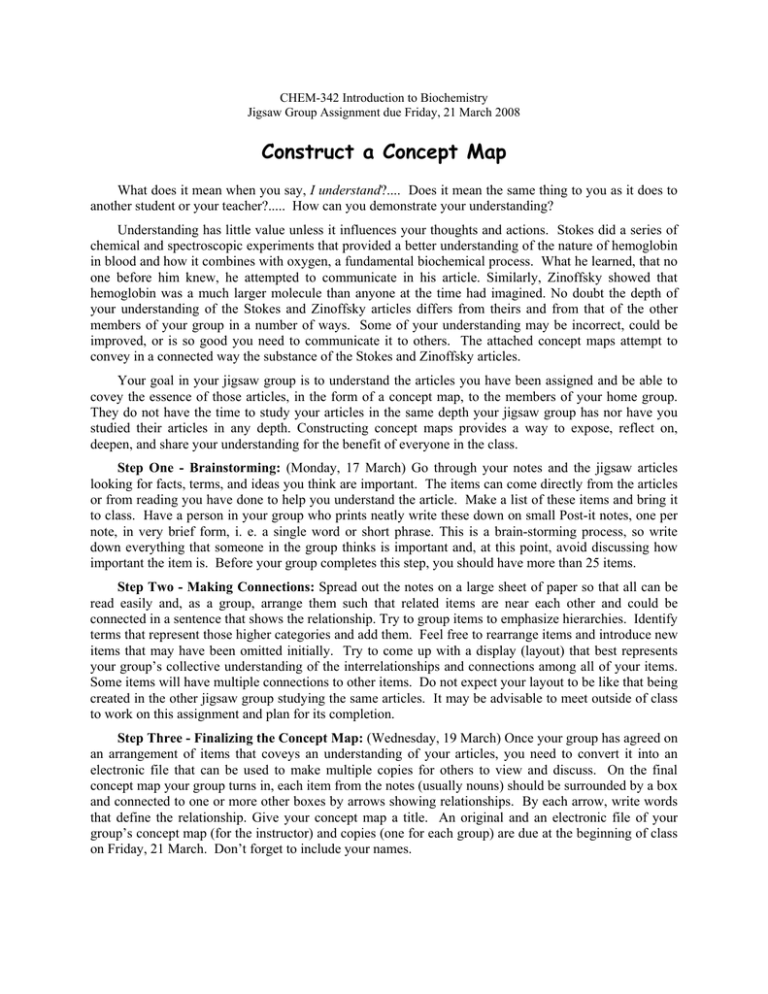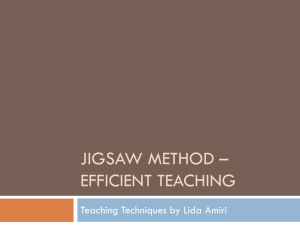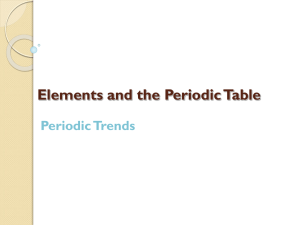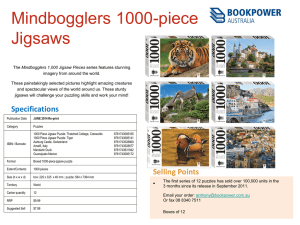Construct a Concept Map
advertisement

CHEM-342 Introduction to Biochemistry Jigsaw Group Assignment due Friday, 21 March 2008 Construct a Concept Map What does it mean when you say, I understand?.... Does it mean the same thing to you as it does to another student or your teacher?..... How can you demonstrate your understanding? Understanding has little value unless it influences your thoughts and actions. Stokes did a series of chemical and spectroscopic experiments that provided a better understanding of the nature of hemoglobin in blood and how it combines with oxygen, a fundamental biochemical process. What he learned, that no one before him knew, he attempted to communicate in his article. Similarly, Zinoffsky showed that hemoglobin was a much larger molecule than anyone at the time had imagined. No doubt the depth of your understanding of the Stokes and Zinoffsky articles differs from theirs and from that of the other members of your group in a number of ways. Some of your understanding may be incorrect, could be improved, or is so good you need to communicate it to others. The attached concept maps attempt to convey in a connected way the substance of the Stokes and Zinoffsky articles. Your goal in your jigsaw group is to understand the articles you have been assigned and be able to covey the essence of those articles, in the form of a concept map, to the members of your home group. They do not have the time to study your articles in the same depth your jigsaw group has nor have you studied their articles in any depth. Constructing concept maps provides a way to expose, reflect on, deepen, and share your understanding for the benefit of everyone in the class. Step One - Brainstorming: (Monday, 17 March) Go through your notes and the jigsaw articles looking for facts, terms, and ideas you think are important. The items can come directly from the articles or from reading you have done to help you understand the article. Make a list of these items and bring it to class. Have a person in your group who prints neatly write these down on small Post-it notes, one per note, in very brief form, i. e. a single word or short phrase. This is a brain-storming process, so write down everything that someone in the group thinks is important and, at this point, avoid discussing how important the item is. Before your group completes this step, you should have more than 25 items. Step Two - Making Connections: Spread out the notes on a large sheet of paper so that all can be read easily and, as a group, arrange them such that related items are near each other and could be connected in a sentence that shows the relationship. Try to group items to emphasize hierarchies. Identify terms that represent those higher categories and add them. Feel free to rearrange items and introduce new items that may have been omitted initially. Try to come up with a display (layout) that best represents your group’s collective understanding of the interrelationships and connections among all of your items. Some items will have multiple connections to other items. Do not expect your layout to be like that being created in the other jigsaw group studying the same articles. It may be advisable to meet outside of class to work on this assignment and plan for its completion. Step Three - Finalizing the Concept Map: (Wednesday, 19 March) Once your group has agreed on an arrangement of items that coveys an understanding of your articles, you need to convert it into an electronic file that can be used to make multiple copies for others to view and discuss. On the final concept map your group turns in, each item from the notes (usually nouns) should be surrounded by a box and connected to one or more other boxes by arrows showing relationships. By each arrow, write words that define the relationship. Give your concept map a title. An original and an electronic file of your group’s concept map (for the instructor) and copies (one for each group) are due at the beginning of class on Friday, 21 March. Don’t forget to include your names. CHEM-342 Introduction to Biochemistry Rubrics for Evaluating Concept Maps for Jigsaw Group Assignment Assignment: Your goal in your jigsaw group is to understand the article(s) you have been assigned and be able to covey the essence of those articles, in the form of a concept map, to the other members of the class. Grading Rubrics: This is an undergraduate course where performance below a “C” is unsatisfactory. The guidelines (rubrics) below indicate how the quality of the concept maps will be evaluated. ~Wt 5 Quality Criterion Title 15 Layout & Appearance 15 Clarity 25 Thoroughness 25 Accuracy 10 Creativity 5+ Other Issues Excellent (A/A+) Very Good (B+/A-) Good (B-/B) Acceptable (C+/C) Creative or informative title that attracts interest and reflects significance of the articles Laid out such that the hierarchy of concepts and their relationships are evident. Space used effectively. Focus drawn to major theme. Terms/concepts and their linking relational descriptors are concise, meaningful, and easy to understand. Arrows emanate from a single source and flow logically to multiple end points. Major concepts addressed. Related subordinate concepts integrated to make relevant connections. Peripheral details limited to support of major concepts. Devoid of obvious misconceptions and free of mistakes. Appropriate and needed connections made between concepts. Purpose or significance of the articles conveyed in the title. Attractive layout supports hierarchical structure for the most part. Terms/concepts and linking words usually precise and concise. Flow usually smooth. Accurate title that may not convey the main purpose or significance of the articles. Hierarchical structure present but focus partially obscured. Layout may not use space fully or effectively. Main ideas apparent and usually understandable. Some problems with words that define relationships. Title includes inaccuracies or misunderstandings Major concepts addressed. A few relevant cross connections missing. A few minor misconceptions present. Relevant connections usually made. Distinctive elements reasonably support the purpose of communication and understanding. Major concepts addressed. Development of cross connections and subordinate concepts occasionally weak. Main concepts presented with some obvious knowledge gaps or misunderstandings. Contains distinctive elements that significantly enhance the interest and relevance of the exercise, e.g. layout, color, and fonts used effectively, simple appropriate icons employed without dominating or being distracting. Distinctive elements contribute to the overall quality but may be inconsistently applied. Layout poorly supports the conceptual structure. Parts of space crowded while other space unused. Multiple origin points disrupt flow of relationships. Imprecise word selection obscures relationships sometimes. Most major concepts addressed. Poor balance between concepts and peripheral details. Overall conceptual structure present but significant gaps in understanding apparent. Creative elements may contribute to appearance but detract from conceptual understanding. Inadequate (C- or lower) No title or title inappropriate for the articles’ significance. Chaotic, sloppy, and/or difficult to read. Confusing due to poor or incorrect word choices. Inappropriate or insignificant connections made. Significant omissions of important concepts or relationships. Focus on peripheral details. Multiple examples of lack of conceptual understanding. Creativity, if present, disconnected from the purpose of the assignment. Minimal effort. Turned in late. Missed the point of the assignment. HBW 2005





